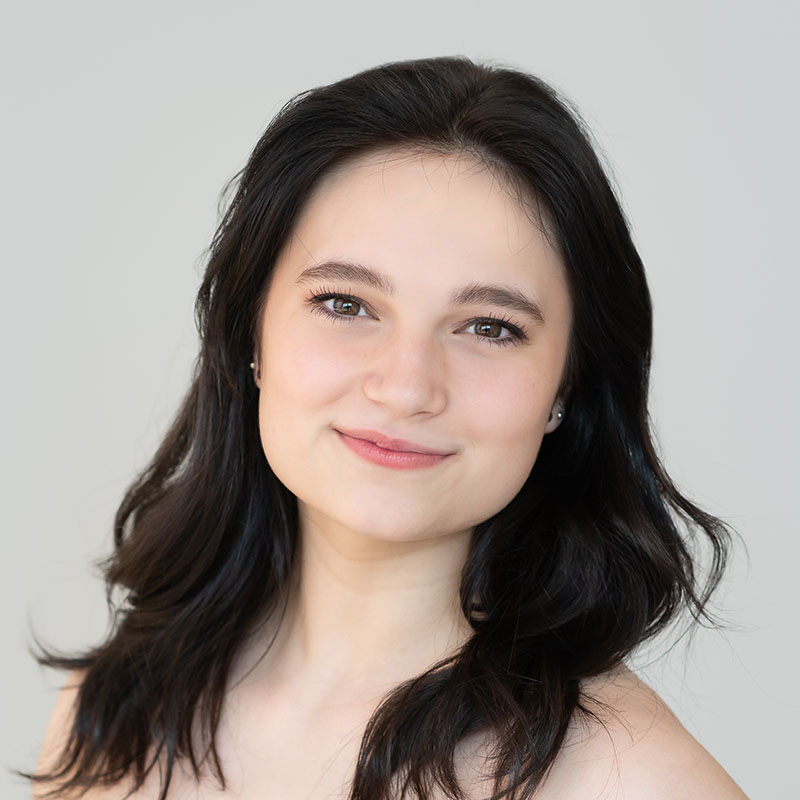CCM presents Cendrillon fairy tale opera Nov. 13-15
Event: November 13, 2025 1:12 PM
UC College-Conservatory of Music's 2025-26 theatre season continues with Cendrillon, playing Nov. 13-15, 2025 in Patricia Corbett Theater.
CCM Chamber Choir PRESENTS
7 p.m. Saturday, Oct. 29, 2022, Christ Church Cathedral
Joe Miller, music director and conductor
Taylor Carrasco, guest choreographer
Sharon Huizinga, lighting designer
Rama VanGils, associate lighting designer
Featuring faculty artist Elliot Madore, baritone
Featuring guest artists from Cincinnati Ballet
By Joe Miller, CCM Professor and Director of Choral Studies
Mexican poet Rosario Castellanos (1925-74), ends her poem La anunciación by stating:
Porque desde el principio me estabas destinado
era mi soledad un tránsito sombrío
y un ímpetus de fiebre inconsolable.
Because from the start you were fated to be mine
my solitude was a somber passage,
an impetus of inconsolable fever.
In Bach’s exuberant Magnificat in D Major, he celebrates the miracle of anticipating new life, but he also illuminates the anxiety and trepidation that Mary feels. Giving birth for the first time comes with a tidal wave of emotion. As family members we often focus on the joy and anticipation of birth, but it is equally important to consider the gravity and worry that a woman must experience. The attraction to this work is in the tension between these contrasting emotional states.
In opposition to the Magnificat, the text and music of Bach’s famous solo cantata Ich habe genung offers a glimpse into the end of life. This cantata written for the Feast of the Purification of the Blessed Virgin Mary is now celebrated on the second day of Christmas. Ulrich Leisinger tells us that: “the Bible reading for the feast is from St. Luke, 2:25. In this reading, it was revealed to the god-fearing Simeon that he should not see death before he had seen Christ, the Lord’s anointed. He was brought by the Holy Spirit to the temple, where Mary and Joseph were present. There, he took the child Jesus in his arms, praised God and said: ‘Lord, now lettest thou thy servant depart in peace, according to thy word: For mine eyes have seen thy salvation.' This sentence is implicit in the libretto, characterized by the joyful expectation of death, which an unknown librettist compiled for Johann Sebastian Bach.” As in the Magnificat, the text and music of Ich habe genung creates the tension between life and death.
Guest artist Taylor Carrasco and I developed this program by weaving together a narrative built from both works. The order was determined by building contrast in the emotional states of the characters and the attention to light and dark. Through dance and Bach’s meaningful music we hope to draw attention to the commonalities that we share as human beings. Our shared experience of life and death are viscerally expressed through art. The music of the body and the movement of sound are natural conduits for expression.
Johann Sebastian Bach (1685-1750)
Johann Sebastian Bach
Featuring faculty artist Elliot Madore, baritone
Featuring faculty artist Elliot Madore, baritone
Featuring faculty artist Elliot Madore, baritone

Cincinnati Ballet Corps de Ballet member

Cincinnati Ballet CB2 Dancer

Cincinnati Ballet CB2 Dancer

Cincinnati Ballet CB2 Dancer

Cincinnati Ballet CB2 Dancer
CCM's Choral Studies Program is internationally recognized for more than 50 years of excellence in training conductors for successful, lifelong careers in the choral arts. Our choral ensembles are proud to offer transformative musical experiences for singers and audiences. Performances range from acclaimed staged productions presented in collaboration with CCM’s Opera Department to presentations of contemporary works.
the flair and technique of a professional ensemble
Rafael's Music Notes
Joe Miller, music director and conductor
Matthew Lee and Matthew Swope, graduate assistant conductors
Stay up to date on CCM news and events by subscribing to our Next OnStage email newsletter, which is published every other Wednesday. Visit ccm.uc.edu/subscribe or text* CCMONSTAGE to 22828 to sign up for email updates. *Message and data rates may apply.
You can also connect with us on Facebook, Twitter, Instagram, YouTube and LinkedIn.
CCM will share its spring 2023 schedule of performances and public events in November.
Event: November 13, 2025 1:12 PM
UC College-Conservatory of Music's 2025-26 theatre season continues with Cendrillon, playing Nov. 13-15, 2025 in Patricia Corbett Theater.
Event: October 23, 2025 1:54 PM
UC College-Conservatory of Music's 2025-26 theatre season continues with "The Lightning Thief: The Percy Jackson Musical", playing Oct. 23-25, 2025 in Patricia Corbett Theater. Tickets are on sale now through the CCM Box Office.
October 3, 2025
UC College-Conservatory of music celebrates Pulizter and Grammy Award-winning composer Jennifer Higdon during her residency at CCM on Oct. 16-18, 2025. Audiences are invited to experience the music of this contemporary classical composer in a variety of free and ticketed concerts; tickets on sale through the CCM Box Office.
CCMpower is a volunteer group of fans, advocates and alumni dedicated to empowering students and fueling the future of the arts through scholarship opportunities and more.
The competitive scholarships CCMpower provides help attract and retain the best and brightest students, nurture professional development opportunities and – in turn – continue CCM’s tradition of excellence for the next generation of student-artists. Join or renew your CCMpower membership today to help provide critical scholarship funds.
Join or renew your CCMpower member today to help provide critical scholarship funds. Visit foundation.uc.edu/ccmpower to learn more.
Sponsors listed as of August 15, 2025
The Cincinnati area and the land that the University of Cincinnati has been built on is the native homeland of the Indigenous Algonquian speaking tribes, including the Delaware, Miami, and Shawnee tribes.
Located in the CCM Atrium, the Box Office is open Monday through Friday, 12:30-6 p.m.; Saturday, noon-4 p.m.; and one hour prior to curtain for all ticketed performances. MasterCard, Visa and Discover cards are accepted.
If you find that you cannot attend your performance, your tickets may be donated for tax credit as a charitable contribution. Simply notify the Box Office prior to the performance to release your seats, and give your name and address. A tax donation receipt will be mailed to you.
If you have lost an item, contact lost and found at 513-556-9413.
The House Manager has been instructed to minimize the disturbance to patrons already seated when accommodating latecomers. The director and producer of each production select times that are least likely to interrupt the performance, and latecomers will be seated only during these times. Latecomers who miss these opportunities will not be admitted until intermission. Children under the age of 6 will not be admitted.
The video or audio recording of performances is prohibited.
The use of cameras, with or without flashes, recording devices, cellular phones and other electronic devices inside the theater is prohibited. Please leave them with the House Manager.
Smoking and refreshments are not permitted in the theater. Effective May 1, 2017, smoking and tobacco use (including chewing tobacco and electronic cigarettes) shall be prohibited by students, staff, faculty, visitors, vendors and contractors at all times in or on University of Cincinnati properties, including events on university property during non-school hours. This includes all shelters, indoor and outdoor theaters and athletic facilities, bridges, walkways, sidewalks, residence halls, parking lots, and street parking and garages owned by the university.
Telex listening devices are available for checkout during performances in both Patricia Corbett Theater and Corbett Auditorium. Please inquire at the Box Office.
Wheelchair seating is available in both Corbett Auditorium and Patricia Corbett Theater. Seating is limited, so reservations should be made with the Box Office when ordering tickets. These seats are subject to availability.
The Box Office can accommodate groups for major productions and concerts. Preview and benefit performances are also available for some productions. For more information, call the CCM Box Office at 513-556-4183.
CCM's faculty and staff and its state-of-the-art facilities make possible the professional training and exceptional education on which CCM believes the future of the arts relies. The school's roster of eminent faculty regularly receives distinguished honors for creative and scholarly work, and its alumni have achieved notable success in the performing and media arts. More than 150 internationally recognized faculty members work with students from around the world, specializing in eight areas of study.
Performance dates and repertoire are subject to change. View CCM's current calendar of events.
The purpose of these performances is educational, and they are part of a University of Cincinnati academic program.